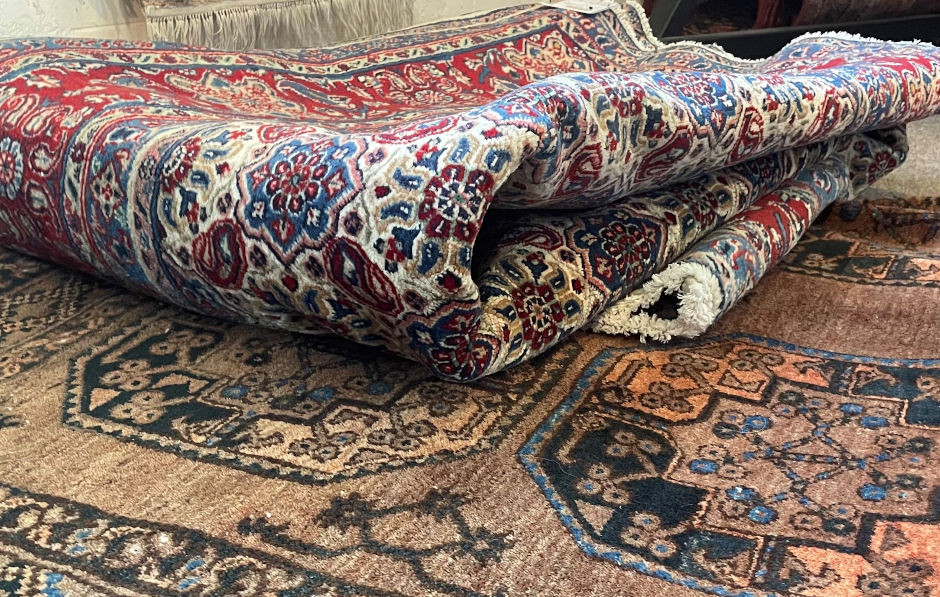
The addition of an antique Persian or oriental rug can, as American interior designer Nate Berkus said, “take your room from ‘carbon copy’ to ‘simply yours’ in no time.” But with the vast array of rugs available, the novice can be forgiven for not knowing his Persian from his oriental, or his knot count from his fringes.
What is a Persian rug and what is an oriental rug?
The main difference between the two is the country of origin. As the name suggests, Persian rugs originate from the Persian Empire, but today, with the fluidity of borders, they were mainly crafted in what is now known as Iran. There are indigenous Pakistani weavers who also produce tribal Persian rugs. By comparison, an authentic oriental rug is likely to have been crafted in what was once known as The Orient, and will include China, Nepal, India, Tibet, Turkey and Afghanistan. Thus, all Persian rugs are oriental rugs but not all oriental rugs are Persian.
Different types of Persian rugs
Persian rugs are generally categorised as city, village or tribal depending on where or who made them. City rugs are known for being the highest quality, with the predominantly male city weavers referred to as ‘master weavers’, while village or tribal rugs were generally produced by family groups.
Antique Baluch rugs
A Baluch, or sometimes Beluch, rug is named after the term given to smaller, nomadic tribes from the Afghanistan borders. Baluch rugs featured deep, rich colours and were often long and narrow, like a runner, as they were used as prayer rugs.
Antique Kashan rugs
Crafted in the city of Kashan, these rugs are considered to be amongst the finest produced. Made from the highest quality sheep’s wool, a traditional Kashan rug features blue, red and beige shades and is characterised by curvilinear designs dating from the early 1900s.
Features of an authentic oriental rug
Hand-knotting. Oriental and Persian rugs are crafted by hand-knotting on looms. The higher the knot count, the better the quality and craftmanship of the rug; a Persian rug of the finest quality could have up to 160 hand knots per square inch. Oriental rugs are vertically knotted, although some, such as kilims, are woven horizontally which renders them courser and flatter.
The reverse of the rug. Genuine antique, hand-knotted rugs will have a pattern on the reverse that exactly matches the pattern on the front. The absence of a backing will also mean that the underside will be soft.
Colour. Oriental and Persian antique rug makers used plant and animal dyes to create the vibrant colours in their work, and these dyes are completely colourfast. The vegetable dyes that were popular in the 1800s fade with age and exposure to sunlight, which make the hues mellower and softer with age.
Patterns. Patterns were limited only by the imagination of the rug maker but there are traditional motifs and patterns to look for. These include floral designs and rosettes, geometric shapes and diamonds. Central medallions were also popular.
How to spot a fake Persian rug
Each antique Persian and Oriental rug is 100% unique due to the nature of craftmanship, and while designs may be repeated across several pieces, no two will be the same. Beware, then, of sellers offering the same rug in different sizes as these will probably have been machine produced.
A hand-knotted rug will never be completely symmetrical and its shape will always be slightly uneven. The antique rug makers could take several months to complete a piece with numerous people working on one rug, making it impossible for a pattern to be replicated exactly. Where the pattern is symmetrical and mirrored, it is likely that the rug was machine manufactured. Imperfections are a good indication of authenticity.
Check any fringing. In a genuine rug, the fringing is an integral part of the rug which is created during the weaving and knotting process. If the fringing appears to have been sewn in place, it is unlikely to be genuine.
Vegetable dyes in genuine rugs are colourfast so a damp cloth placed on a rug should have no colour transfer; colour-free indicates a genuine piece. Age will also have softened the colours, so beware any rug which has overly-bright and garish colours.
The underside of an authentic Persian rug will show the knots that have been hand tied to create the pattern. By comparison, a hand-tufted rug will have a canvas backing that the design is punched through with a tufting gun, similar to a stencil design.
When looking for antique rugs for sale, it is important to buy from an experienced dealer. At Hemswell Antique Centres, our dealers have the expertise to ensure you make the perfect purchase. For buyers looking for multiple purchases, we are able to offer virtual tours which will allow us to show you an extensive selection of the antique rugs we have available. This service is particularly beneficial to our overseas clientele and details can be found here.